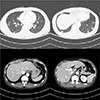Abstract
Toxocariasis is an important cause of secondary hypereosinophilia in Korea. Here, we describe a rare case of toxocariasis presenting as transient global amnesia due to secondary hypereosinophilia. A 44-year-old male visited the Emergency Department (ED) for transient global amnesia. He ate raw cow liver and omasum 2 weeks before the ED visit. The initial peripheral blood eosinophil count was 15,250/µL and serologic test for serum specific IgG antibodies to Toxocara canis larval antigen was positive. Radiologic studies revealed multiple small embolic infarctions of brainwithout cardioembolic sources or vascular abnormalities. He was treated with systemic corticosteroid, and neither neurologic deficit nor motor deficit was left. In our current case, the patient have a history of frequently eating raw cow liver and omasum, and his total IgE level was extremely high (>5,000 IU/mL). Thus, the patient was diagnosed as having toxocariasis and secondary hypereosinophilia. Toxocariasis should be considered in the differential diagnosis in patients with eosinophilia and atypical neurologic symptoms, such as transient amnesia.
Figures and Tables
 | Fig. 1Diffusion-weighted magnetic resonance imaging showing multiple high-signal intensities in both cerebral and cerebellar hemispheres. |
References
1. Valent P, Klion AD, Horny HP, Roufosse F, Gotlib J, Weller PF, et al. Contemporary consensus proposal on criteria and classification of eosinophilic disorders and related syndromes. J Allergy Clin Immunol. 2012; 130:607–612.

2. Kim HS, Jin Y, Choi MH, Kim JH, Lee YH, Yoon CH, et al. Significance of serum antibody test for toxocariasis in healthy healthcare examinees with eosinophilia in Seoul and Gyeongsangnam-do, Korea. J Korean Med Sci. 2014; 29:1618–1625.

3. Woodhall DM, Eberhard ML, Parise ME. Neglected parasitic infections in the United States: toxocariasis. Am J Trop Med Hyg. 2014; 90:810–813.

4. Watthanakulpanich D. Diagnostic trends of human toxocariasis. J Trop Med Parasitol. 2010; 33:44–52.
5. Dattoli VC, Freire SM, Mendonça LR, Santos PC, Meyer R, Alcantara-Neves NM. Toxocara canis infection is associated with eosinophilia and total IgE in blood donors from a large Brazilian centre. Trop Med Int Health. 2011; 16:514–517.

6. Han WH, Kim JE, Do JK, Jung BW, Kwoun HH. Multiple cerebral infarctions associated with toxocariasis-induced secondary hypereosinophilia. Korean J Stroke. 2010; 12:109–111.
7. Lee KE, Kang HS, Yu HJ, Roh SY. Multiple cerebral infarction associated with toxocariasis. J Neurocrit Care. 2011; 4:14–16.
8. Lee D, Ahn TB. Central nervous system involvement of hypereosinophilic syndrome: a report of 10 cases and a literature review. J Neurol Sci. 2014; 347:281–287.





 PDF
PDF ePub
ePub Citation
Citation Print
Print





 XML Download
XML Download